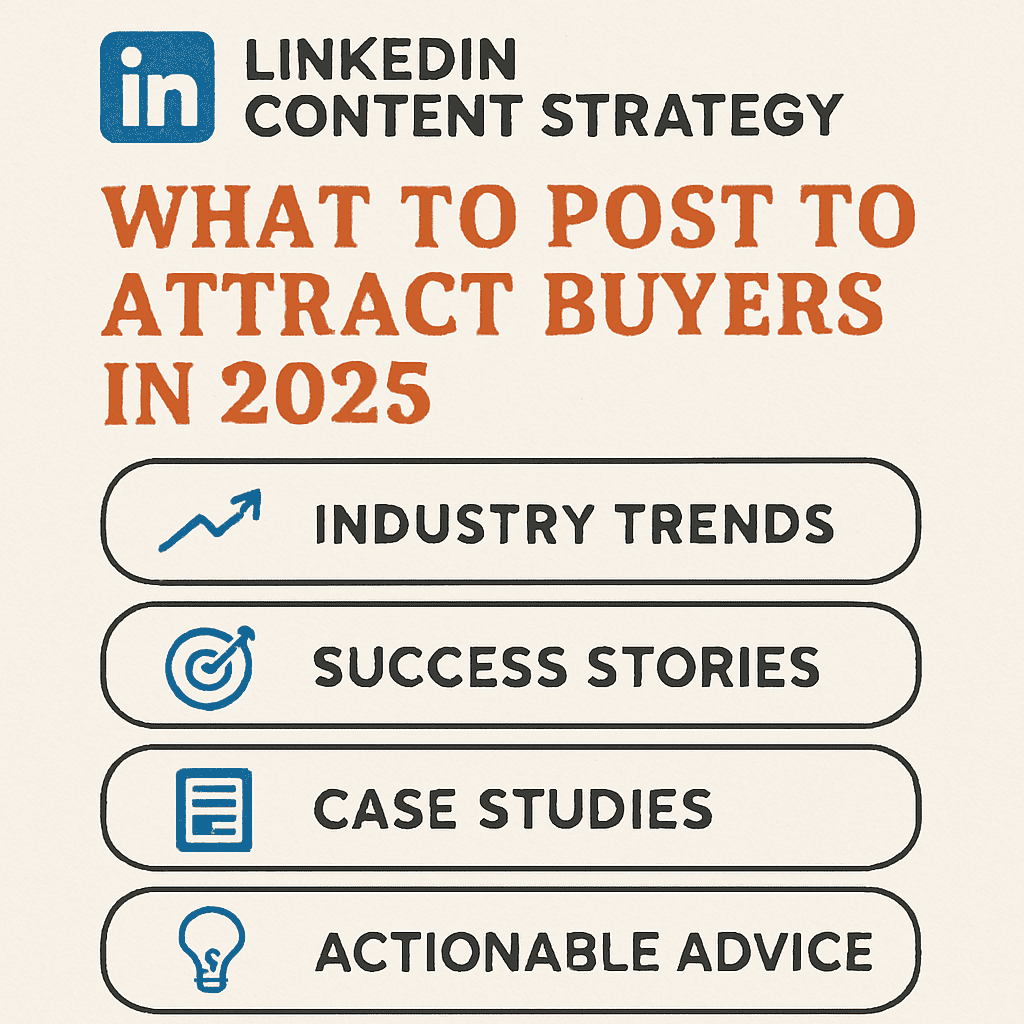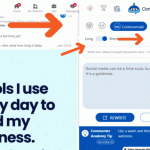
LinkedIn Content Strategy What to Post to Attract Buyers in 2025
As we look toward 2025, LinkedIn continues to be an essential platform for professionals and businesses alike. It’s not just a job-hunting site; it’s a powerful tool for building brand awareness, generating leads, and attracting buyers. But with the ever-evolving digital landscape, how can businesses ensure their LinkedIn content strategy remains effective? This article delves into the best practices and content ideas to attract buyers on LinkedIn in 2025.
The Evolution of LinkedIn Content Strategy
LinkedIn has transformed significantly over the years. Initially launched as a professional networking site, it has expanded to become a comprehensive platform for content marketing, brand building, and lead generation. By 2025, LinkedIn is expected to integrate even more advanced features, such as AI-driven content recommendations and personalized networking suggestions, making it a pivotal tool for B2B marketers. The platform’s evolution is also marked by its enhanced analytics capabilities, allowing users to gain deeper insights into their audience’s preferences and behaviors.
The Growing Demographics of LinkedIn Users
LinkedIn’s growth is not just technological but also demographic. The user base is becoming increasingly diverse, with more industries and age groups represented than ever before. This diversity requires businesses to adapt their LinkedIn content strategy to cater to a wider range of interests and professional backgrounds. Understanding these shifts is crucial for crafting content that resonates with the evolving LinkedIn audience.
Why a LinkedIn Content Strategy is Essential
A well-crafted LinkedIn content strategy is crucial for standing out in a crowded marketplace. It helps businesses communicate their brand message, engage with their audience, and ultimately drive sales. In 2025, the emphasis will be on creating authentic, value-driven content that resonates with your target audience. This involves not only delivering high-quality content but also ensuring that it aligns with the values and interests of your audience.
Leveraging LinkedIn Features for Maximum Reach
The importance of a LinkedIn content strategy extends beyond just content creation; it encompasses distribution and optimization as well. Businesses must strategically leverage LinkedIn’s features such as hashtags, LinkedIn Stories, and the LinkedIn Publishing Platform to maximize their content’s reach and impact. Additionally, an effective strategy involves regular evaluation and adaptation based on performance metrics and audience feedback.
The Role of LinkedIn in B2B Marketing
As LinkedIn becomes increasingly integral to B2B marketing, its role extends beyond just a networking platform. It serves as a hub for industry news, a venue for professional development, and a marketplace for B2B transactions. By 2025, LinkedIn will likely introduce more features tailored to B2B marketers, such as enhanced targeting options for ads and improved tools for lead nurturing.
Integrating LinkedIn into Your Broader Marketing Strategy
Businesses must recognize LinkedIn’s potential as a comprehensive B2B marketing tool and integrate it into their broader marketing strategies. This involves not only creating engaging content but also fostering relationships through meaningful interactions and collaborations. By leveraging LinkedIn’s unique capabilities, businesses can enhance their brand visibility, establish thought leadership, and ultimately attract more buyers.
Defining Goals for Your LinkedIn Content Strategy
Before crafting content, it’s vital to understand who you’re talking to and what you want to achieve. Are you looking to build brand awareness, generate leads, or foster engagement? Knowing your goals will help shape your LinkedIn content strategy. Start by identifying your target audience’s demographics, interests, and pain points. This information will guide your content creation and ensure that your messaging is relevant and impactful.
Setting Clear KPIs for LinkedIn Content Success
Defining clear goals involves setting measurable objectives and key performance indicators (KPIs). For example, if your goal is to generate leads, you might focus on metrics such as conversion rates and lead quality. On the other hand, if your aim is to build brand awareness, you might prioritize metrics like reach and engagement. By establishing clear goals and KPIs, you can effectively track your progress and make data-driven decisions to optimize your strategy.
The Importance of a LinkedIn Content Calendar
A content calendar is an essential tool for planning and organizing your posts. It ensures consistency and allows you to strategically time your content to align with industry trends and events. In 2025, a well-planned calendar will include a mix of media types, such as articles, videos, and infographics, to keep your audience engaged. Your calendar should also account for seasonal trends and industry-specific events to maximize relevance and impact.
Timing and Frequency of LinkedIn Posts
In addition to planning content types, a content calendar should outline the frequency and timing of your posts. This involves understanding when your audience is most active on LinkedIn and scheduling your posts accordingly. Consistency is key, as regular posting helps maintain audience engagement and reinforces your brand presence. By using a content calendar, you can streamline your content creation process and ensure that your messaging remains coherent and aligned with your goals.
Crafting Compelling Messaging for LinkedIn Content
Effective LinkedIn content strategy requires more than just informative content; it demands compelling messaging that resonates with your audience. Craft your messaging to highlight your unique value proposition and differentiate your brand from competitors. This involves understanding your audience’s pain points and addressing them directly in your content. Use storytelling techniques to create a narrative that engages your audience emotionally and intellectually.
The Role of Personalization in LinkedIn Content Strategy
In 2025, personalization will be a critical component of compelling messaging. Tailor your content to address the specific needs and preferences of different segments of your audience. This might involve creating targeted content for various industries, job roles, or regions. By delivering personalized messaging, you can enhance audience engagement and foster deeper connections with your brand.
Building Thought Leadership with LinkedIn Content
Establishing your brand as a thought leader is crucial for attracting buyers. As a key element of an effective LinkedIn content strategy, publishing insightful articles that address industry challenges, offer practical solutions, and showcase your expertise helps build lasting credibility. Thought leadership content not only positions you as a trusted authority but also fosters deeper trust and engagement with your audience. These articles should be well-researched and offer unique perspectives that set your brand apart within your niche.
Using Multimedia to Strengthen Thought Leadership
A powerful LinkedIn content strategy doesn’t rely solely on text. Enhance your thought leadership by incorporating multimedia elements such as infographics, charts, and videos. These additions simplify complex concepts and make your content more visually engaging and accessible. Beyond publishing, true thought leadership also involves interacting—consistently commenting on relevant posts, starting discussions, and sharing expert takes to reinforce your presence and influence on LinkedIn.
The Power of Video in LinkedIn Content Strategy
Video content continues to dominate social media, and LinkedIn is no exception. As part of a strong LinkedIn content strategy, creating short, engaging videos can capture attention and provide real value to your network. Whether it’s a product demonstration, customer testimonial, or industry insight, videos can effectively communicate your message and significantly boost engagement. In 2025, interactive video formats—like 360-degree experiences and shoppable videos—will become increasingly popular, offering new ways to engage and convert viewers
Optimizing Video for Mobile and Accessibility
To maximize the impact of your video content within your LinkedIn content strategy, ensure it’s optimized for mobile: concise, visually appealing, and understandable without sound. Including captions not only enhances accessibility but also increases watch time. By incorporating video into your overall strategy, you can humanize your brand, simplify complex topics, and leave a lasting impression on your audience.
Engaging Your Audience with Interactive Content
Interactive content, such as polls and quizzes, encourages audience participation and drives engagement. As part of a well-rounded LinkedIn content strategy in 2025, leveraging LinkedIn’s interactive features can help you gather valuable insights about your audience and tailor your content accordingly. Interactive posts not only spark engagement but also open doors to real-time feedback, offering a clearer understanding of your audience’s preferences and behaviors.
Incorporating Webinars and Virtual Events
Beyond polls and quizzes, consider incorporating other forms of interactive content such as interactive infographics, webinars, and virtual events. These formats allow for more in-depth engagement and provide opportunities for direct interaction with your audience. By embracing interactive content, you can create dynamic experiences that foster deeper connections and enhance your brand’s visibility on LinkedIn.
The Importance of Authenticity in LinkedIn Content Strategy
Beyond polls and quizzes, a diversified LinkedIn content strategy should also include interactive formats like infographics, webinars, and virtual events. These formats support deeper engagement and enable direct interaction with your audience. By embracing interactive content across multiple formats, you can create dynamic experiences that foster stronger relationships and elevate your brand’s visibility on LinkedIn.
Consistent Authentic Interactions
Authenticity extends beyond just content creation; it involves consistent and genuine interactions with your audience. Respond to comments and messages with sincerity and engage in meaningful conversations that demonstrate your commitment to your audience’s needs. By prioritizing authenticity, you can build trust and loyalty, which are essential for attracting and retaining buyers.
Optimizing Content for Mobile Devices
With more users accessing LinkedIn on mobile devices, it’s crucial to ensure your content is mobile-friendly. Use concise, clear messaging and visually appealing graphics to capture attention on smaller screens. This involves optimizing your content’s layout, font size, and images to ensure they display correctly on mobile devices.
Creating Mobile-Optimized Video and Links
Additionally, consider the mobile user experience when creating content, such as ensuring that videos are optimized for mobile viewing and that links are easily clickable. By prioritizing mobile optimization, you can enhance your content’s accessibility and ensure that it reaches and engages a broader audience.
Analyzing LinkedIn Content Performance
LinkedIn’s analytics tools provide valuable insights into your content’s performance. Use these metrics to refine your LinkedIn content strategy, identify what works, and make data-driven decisions to enhance your content’s effectiveness. Key metrics to monitor include engagement rates, reach, impressions, and conversion rates.
Leveraging LinkedIn Analytics for Optimization
Regularly reviewing your analytics allows you to identify trends and patterns in your content’s performance, enabling you to make informed adjustments to your strategy. Additionally, use LinkedIn’s analytics to gain insights into your audience’s demographics and behaviors, which can inform your content creation and targeting efforts. By leveraging analytics, you can continuously optimize your content strategy and achieve better results on LinkedIn.
Conclusion: Building a Successful LinkedIn Content Strategy in 2025
Crafting a successful LinkedIn content strategy in 2025 requires a thoughtful approach that prioritizes authenticity, engagement, and value. By understanding the evolving LinkedIn landscape, defining clear goals, and leveraging diverse content formats, businesses can effectively attract buyers and drive growth. Keep your audience’s needs at the forefront, stay adaptable, and embrace innovation to maintain a competitive edge on LinkedIn.
By following these guidelines and continuously refining your strategy, you’ll be well-positioned to capitalize on LinkedIn’s potential and achieve your business objectives in 2025 and beyond. Embrace the opportunities that LinkedIn offers, and leverage its unique capabilities to connect with your audience, establish thought leadership, and drive meaningful business results.
Follow us for more actionable LinkedIn content strategies, tips, and tools to help you grow your brand and generate leads in 2025.



